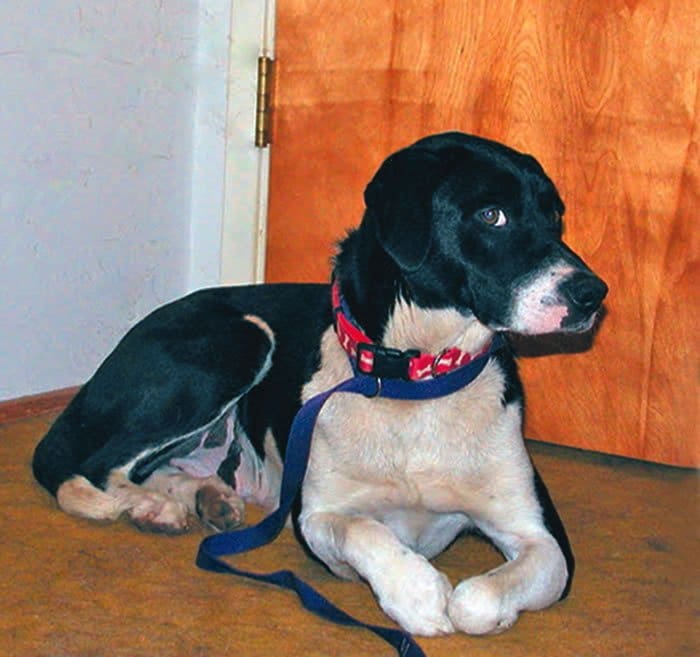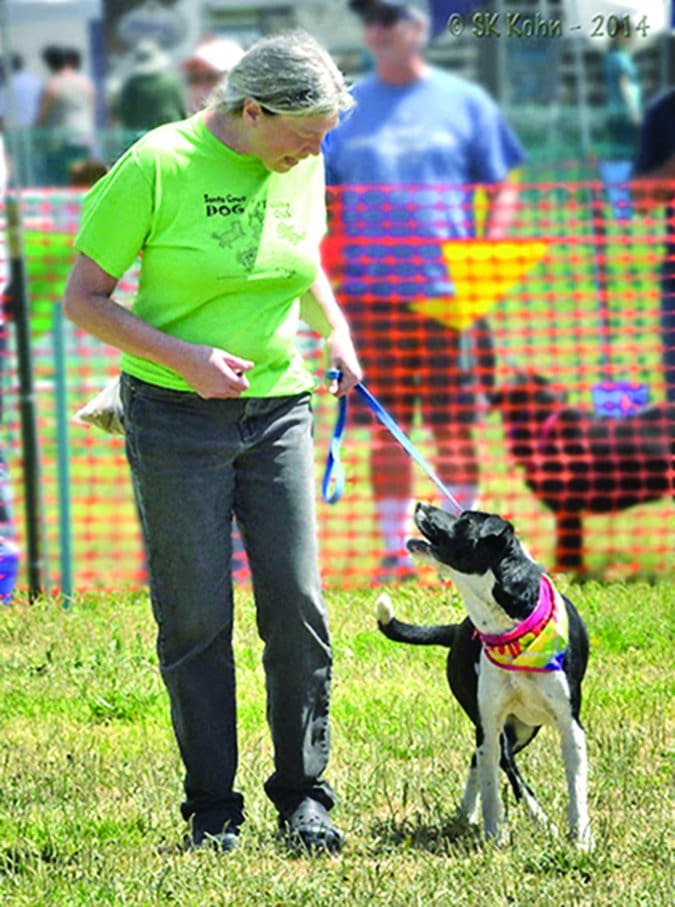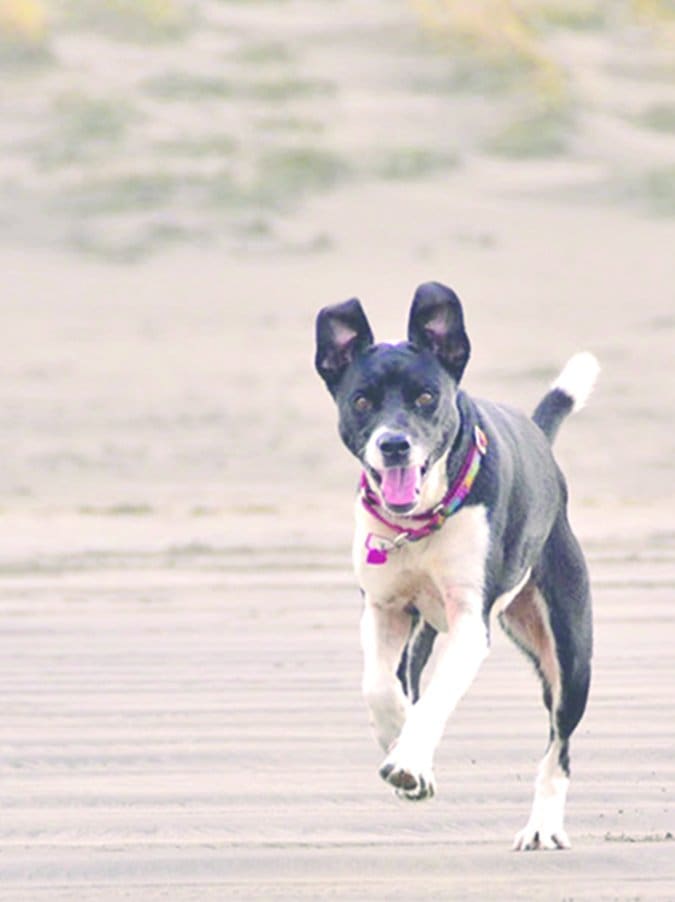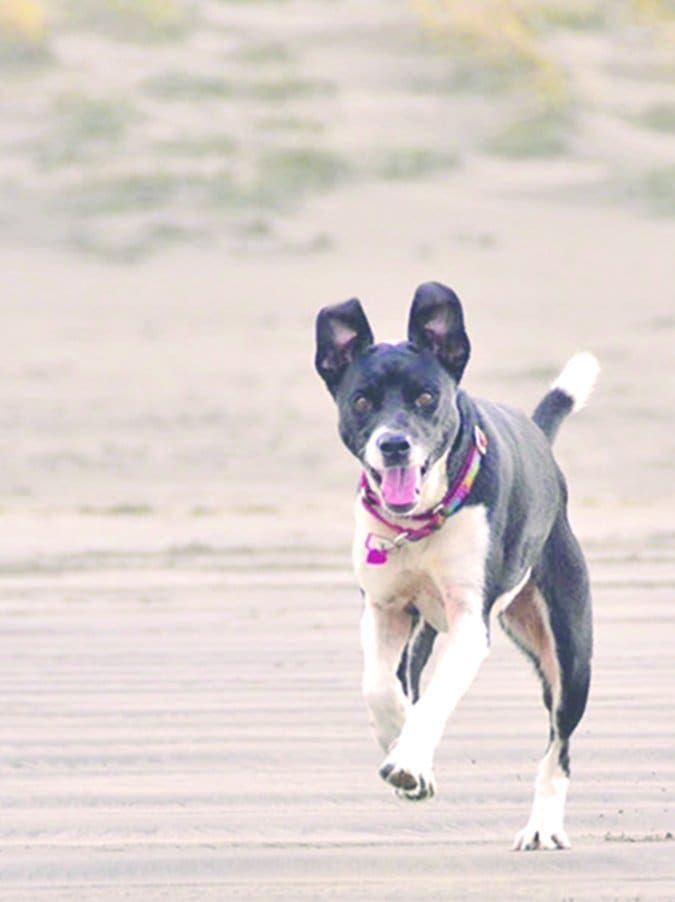Building A Dog’s Trust
There is a certain class of fearful dogs – those who are so afraid they don’t even trust the people who are trying to help them. These dogs can come from the streets, puppy mills, or someone’s backyard. Choosing to work with, foster, or live with a dog who is afraid of people is choosing to embark on a powerful journey. The ups and downs can be emotionally challenging, but the rewards of building a mutual trust where none existed can be an amazing experience.
Dogs may be fearful for a lot of reasons. Some dogs have a genetic predisposition for shyness or fearfulness. Some dogs are undersocialized, and to them the world can seem big and scary. Some dogs may have had traumatic experiences that led to a fearful response. For many dogs, we never really know the reason they are afraid, we just know they are.
Take Trill, for example. Trill is a mixed-breed dog who now shares her life with Evelyn Sharp, DVM, in Aptos, California. Trill was found roaming the streets with another dog. Any or all of the experiences of being lost, landing in the shelter, and getting separated from her companion could have led to a fearful response. She had recently had puppies, and the loss of those pups may have added to her stress and fear. But in Trill’s case, under-socialization and genetics were probably also in play.
At the shelter, one staff member saw some potential in Trill. A volunteer had also connected with her. Both saw some hope for Trill. They thought of Dr. Sharp because she had previously fostered dogs for the shelter, and they called to ask if the veterinarian might be up for taking in a foster dog who needed a little extra attention.
Sharp was not new to working with foster dogs who had a few issues. In fact, she’d just placed another fearful dog who looked remarkably like Trill.
When she first met Trill, Sharp saw that the dog was frightened. In fact, Trill wouldn’t come near Sharp, not even for a treat. But the dog didn’t show the slightest bit of aggressive behavior and seemed to calmly accept the presence of Dr. Sharp’s dog. Sharp concluded that a safe place and a little training would do wonders for this girl. After all, these things had worked well with her previous fosters. She agreed to take Trill home.
Trill turned out to be a greater challenge than Sharp expected – more afraid than she had originally appeared, and completely lacking in trust of humans. Dr. Sharp called me that first day and said, “I’m not sure what I’ve gotten myself into here. I think I’m going to need help.”

When Scared Dogs Escape
Building trust is complicated. Dr. Sharp did what had worked well with her previous fearful foster dogs. She brought Trill into a quiet room in her house to allow her to explore and acclimate. Sharp figured that she would show the dog where to eat and sleep, and let her explore her new surroundings. But Trill didn’t explore. That first day she hid in a corner, her eyes begging Sharp to stay away. “That was hard,” Dr. Sharp recalls. She wanted Trill to know she was safe, wanted the dog to understand that she was an ally. “But we couldn’t get there because she didn’t trust me.”
The second day, Dr. Sharp thought she saw a little improvement. Trill looked as if she was starting to check out the house. It turned out, though, that Trill was looking for a way to escape, and escape she did. She somehow opened the rear sliding door and ran into the woods surrounding Sharp’s house.
“I was so scared for her,” Dr. Sharp remembers. “I didn’t know how we would catch her. I thought she was gone for good.” Hoping for the dog’s return, and in hopes of luring Trill into a confined space where the dog might be caught, Sharp loaded her car with food and water, a familiar blanket, and clothing belonging to the person that Trill had connected with at the shelter. She placed the food inside a crate that sat on the back seat of the car. As luck would have it, Trill entered the car in the middle of the night, and went into the crate – probably for the food. But magically, the door closed behind her, and she was safely trapped.
Steps to Building a Dog’s Trust
After this turn of events, Dr. Sharp knew that building the dog’s trust and sense of safety were the most important things she could do for the young dog.
But it was turning out to be difficult. The house wasn’t big enough for Trill to find a safe spot, where she could relax without appearing to feel crowded. And she took no comfort from the resident dog and cat.
How do you build safety and trust with an animal who is this frightened? The following steps may help:
– First, let the dog be. Sometimes, scared dogs benefit more from being left alone. I offered this advice to Sharp at the time, but the idea was difficult to accept. “The concept was appalling to me,” she recalls; she wanted to keep trying to engage Trill.
But she could also see that what she was doing was not working, so she gave it a try. “When I finally stopped trying to get her to enjoy petting and touching, Trill became more interested in me.” Giving her more space and less attention worked!
– Develop a dependable structure. Sharp knew that a predictable routine had helped her animals and her previous fosters. When a dog knows when and where she will eat and sleep, when it will be time to go out, what others in the house will be doing and when, she may start to calm down. With consistency comes predictability, which can allow the stress hormones surging through a frightened dog’s body to subside. Repeated actions, done in a kind, calm, and non-confrontational manner, can also help build trust.
– Have patience. When you live with a scared dog, you will likely want her to feel safer, to change, to relax, and be happy. And in time, most dogs will, but you can’t rush the process. The change will only happen on the dog’s timetable, not yours. Be patient and wait for her to be ready to take a chance.
You will know your dog is starting to feel safer when she shows interest in you or your activities, for example, if she pokes her head out of her safe spot when you are preparing her dinner. When she is curious, looks at you with soft eyes, or starts to explore – these are signs that your previously frightened dog may be ready for a little engagement.
Making a Connection
Many (but not all) dogs enjoy being touched, and find comfort in having their chests rubbed, or receiving a soft massage behind their ears. The pleasure they receive from the physical contact can inspire the beginnings of a relationship. But Sharp found it difficult to get near Trill, much less touch her. She spooked with movement, so playing with toys wasn’t going to work. Trill would even skitter away when Sharp reached toward her with a treat.
Dr. Sharp got creative, and started to try to communicate with Trill through clicker training. “Training a dog without touching her was new to me,” Sharp says, but she started trying to “shape” Trill’s behavior.
One of the first clicker-trained behaviors she worked on was clipping a leash onto the dog’s collar. Up until that point, Trill would do anything possible to stay just out of reach. At first, Sharp just put some leashes around the house, and began clicking a clicker, and then tossing a treat to the dog, every time Trill looked at or went near one of the leashes.
Soon, Trill realized she received more treats the closer she went to one of the leashes, and she began purposely walking toward and then touching leashes with her nose.
Sharp was then able to then able to pick up a leash and ask Trill to touch (or “target”) it. Trill was learning to play the training game! With a few more days of practice and a little more shaping, Sharp was able to clip the leash on and off of Trill’s collar.
Treats didn’t work as effectively when Sharp began trying to train Trill to sit. At first, when Trill would sit and Sharp would step or even just lean toward the dog to reward her with a treat, Trill would move away. Sharp realized that she needed to reduce the pressure that Trill felt from being too close physically – and that Trill felt more comfortable with more distance between them. So she used that space as a reinforcer; she rewarded the dog for sitting by stepping away from Trill, and Trill would remain sitting.
Target Training
It quickly became clear to Sharp that training was going to be an effective way to connect with and build trust with the dog. The most powerful and transformative behavior that Trill learned – a behavior that led to learning many other behaviors – was hand targeting. “It was fabulous!” Sharp says. She used this simple foundation behavior to guide Trill, inviting the dog to move forward, turn, and come nearer, just with a simple hand touch. Later, she used the technique to encourage Trill to interact with other people.
Over the course of the first year, Sharp taught Trill 30 or more tricks and other behaviors, as well as the names of dozens of actions. Sharp can say the word “eye” and Trill looks up to have her eye cleaned; when she says “chin,” Trill will plop her chin in Sharp’s hand. If she says “pet,” Trill will walk over to get petted. Sharp also taught Trill to scratch her nails on a sandpaper board to keep them from getting too long while they work to improve her comfort with nail clipping.
“Clicker training has been a really big deal for us,” Sharp says. Trill learned that the clicking sound indicated she was doing something right, and that a reward for doing it was on its way.
What about when she wasn’t doing the desired behavior? Well, then nothing happened! The fact that positive results always came when she figured out and did the “right” thing, and that nothing negative happened when she didn’t know or didn’t do the “right” thing, gave her the confidence to keep trying to figure out what the “right” thing was. “With clicker training, we learned to talk to each other, and learned to play,” Sharp says. She credits clicker training with helping Trill lighten up, noting the dog’s enthusiasm and happy demeanor whenever Sharp gives her a cue or starts a training game.
Each and every fearful dog and handler is different. While clicker training worked like magic for Trill and Dr. Sharp, having a larger repertoire of techniques can be helpful. With a different dog or handler, one of these other techniques might provide the critical key to connection.
Classical conditioning is when a dog learns to associate one thing with another; it can be a very powerful tool for fearful dogs. Classical conditioning can occur through natural associations, for example, when you grab your hiking shoes and your dog gets super excited; in this case, she’s associated going for an especially fun or long walk with your hiking shoes.
We can also use classical conditioning to our advantage by design. It can be used to create a positive association for a dog between certain things, as well as to counter-condition something that may cause a fearful response.
For example, I used classical conditioning with my fearful dog to help her stop reflexively exhibiting a fear-based response every time she felt a slight tug on the leash. I started the process by giving her bits of roast beef every time there was an unexpected or gentle, planned tug on the leash. The leash tug would predict roast beef. Very quickly, she went from exhibiting a startled or panicked flight every time the leash tugged her collar, to happily looking back at me for the roast beef.
You can use classical counter-conditioning to help a fearful dog learn to accept you. If food falls from your hands each time you walk by your dog, he will undoubtedly begin to look forward to you walking by. If this is done repeatedly, the dog’s emotional response can begin to shift from fearful to feeling good. One caveat, though: You need to manage the interaction in such a way as to keep the dog below his fear “threshold” – the point at which he’s too frightened to think, much less make a calm, conscious choice of how to behave.
A dog will go “over threshold” when he is too close, exposed for too long, or at too high of an intensity to something that scares him. It’s obvious when some dogs are close to or over threshold; they may panic and try to bolt, or bark or growl in defensive fear. But with some frightened dogs, it may be more difficult to see; some may get abnormally calm and still or display only subtle signs of fear. (For more information on thresholds, see “Across a Threshold,” WDJ April 2013.)

Sandi Kohn
Social facilitation is another tool that may help a frightened dog become less afraid. If you have another dog (and especially if the dogs get along well), your resident dog may be able to show your fearful dog that you are in fact a safe person. When you all walk together, hang out together, and spend time training or playing together, your fearful dog may start to loosen up and see you as part of the group.
Exploring the world together can be very bonding and can build trust and connections. Taking walks together can help you bond. But even if your dog is a little too frightened to walk on a leash, you can explore together at home or in your garden.
For example, when my dog Chance was still new to our home, I would pay attention to the things she was interested in. When Chance would check out a bug on the ground, I would wait until she moved away, and then I would go and check out the bug, too.
Then I would focus on something else, say, a flower in the garden. She would follow me and check out the flower, too!
As this mutual exploration developed, Chance would invite me to follow her and see what she was doing. She also began to follow me to see what I was doing. We bonded through this mutual exploration.

SK Photography
Play can be another effective way to connect with a fearful dog. Some dogs are so afraid that they show no interest in playing. But I have found one type of toy – any sort of stuffed animal or ball on a string or rope – often works very well in engaging a fearful dog in play. With a rope, you can strategically move the toy, to try to entice the dog into chasing it or pouncing on it, without the dog having to be too close to you.
Let the dog “win” frequently, by allowing him to catch the toy or even getting to keep the toy. Getting your dog to have fun with you can help cement a budding trust.
Working With Your Dog’s Outside Triggers
Each of the techniques mentioned above can also help when you have to deal with outside triggers, that is, things in the world that you can’t control, such as a loud truck or motorcycle roaring by. Training and training games can help a dog who is unsure in a new environment acclimate quicker. Classical conditioning can help create new, positive associations as well as help shift your dog’s fearful response to people, other animals, and things to a happier, more confident response. Calm, worldly dogs can help less-socialized dogs learn about unfamiliar environments, and exploration and play can tap into a dog’s sense of fun and adventure, no matter what is going on around them.
Careful introductions to new places, people, and other animals can also help set up your dog for success. Dr. Sharp, for example, works to find Trill’s optimum levels of exposure to new and different things; she watches the dog’s reactions and tries to protect Trill from becoming overwhelmed. “I really pay attention to where Trill is and don’t expect her to be further along,” Sharp says. “I intervene if I know something is too much for her, but I try to walk the line between protecting her and giving her room to explore.”
Positive experiences cause exponential growth, Dr. Shar says. “The neat thing is, each good experience grows on itself.” Each dog Trill meets and has a good experience with opens the door wider for her to meet the next dog. Each person she meets and engages with makes her braver the next time.
Moving Forward from Fear
As you probably already guessed, Trill is no longer a foster; Sharp intends for Trill to share her home for the rest of Trill’s life. They are in their second year of living together, and while it’s much better all the time, a challenge of living with an under-socialized or fearful dog can pop up at any time. Sharp says they still have a long way to go before she’d consider Trill to be a truly confident, trusting dog.
“Trill was more than just fearful about humans when I met her,” Sharp says. “The world was just too much for her. I don’t remember ever working with a dog who was that scared, even in a veterinary setting.”
Today, Sharp says, Trill mostly trusts her, though on occasion the dog will still get that “Should I trust her?” look in her eye. While Trill is better acclimated to the human world, and can go to the beach, travel with Dr. Sharp, and interact comfortably with most people and dogs, she still has a few significant hurdles to overcome. For example, Trill has yet to accept restraint and is resistant to some types of handling. Sharp says they are working on this, but it will likely take a long time before Trill is as comfortable with intimate handling and restraint.
The support of other knowledgable, positive dog people was critical to her success with Trill, Sharp says. She credits working closely with a trainer, as well as “the dog club meetings twice a week, all of the people at those meetings who knew to leave Trill alone and let her be, and the well-trained dogs who gave her room to get used to them slowly. It was all so important.”
But as challenging as it has been, Dr. Sharp says that she would do it again. “Trill is a good kid! She loves to learn and I love to train her. Trill forced me to be creative. She made me learn to train without touching. And now watching her go to the beach and seeing her run and run – it is all really fun.”
Mardi Richmond is a writer and trainer living in Santa Cruz, CA, with her wife and her formerly fearful feral dog, Chance. She is the owner of Good Dog Santa Cruz, where she works with fearful dogs and puppies and utilizes early socialization to prevent fear-based behaviors. Mardi thanks Dr. Evelyn Sharp and Trill for sharing their story.







My miniature schnauzer is scared of everyone including me and my parents. I’m confused why is she so scared of everyone. I wish she won’t be that scared later.